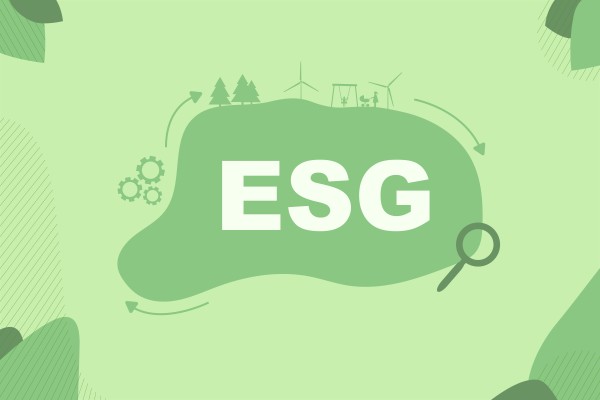Business
Developing an ESG-informed approach to business strategy and management
Business
Developing an ESG-informed approach to business strategy and management
Reviewed by Dr Bronwyn Claire.
In a world where environmental and social concerns are increasingly at the forefront of people’s minds, many businesses are rethinking how they operate. Companies are looking beyond profit margins at how they can reduce their negative environmental impact and contribute positively to society.
Incorporating Environmental, Social and Governance (ESG) principles into your business strategy isn’t just about saving the planet. It’s about future-proofing your organisation, attracting socially conscious customers and investors, and standing out in a competitive marketplace.
In this article, Dr Bronwyn Claire – joint author of the Cambridge Advance Online course ESG Risk Management – explores how using a sustainable approach to business strategy and management can reshape your organisation for the better. She will share actionable insights into developing a sustainable business strategy that drives long-term success.
What is an ESG-driven approach to business strategy and management?
An ESG-informed business strategy embeds environmental, social and governance considerations into every decision-making process. This isn’t about superficial actions or ticking boxes – it’s about fundamentally shifting how a business operates. This means redefining procedures and processes to include sustainability at the core of everything you do, from production methods to labour practices and governance frameworks.
At its heart, this ESG-driven, sustainable approach seeks to combine long-term profitability with positive contributions to the environment and society. It’s about creating a more ethical, transparent and responsible organisation – one that meets today’s market demands and is prepared for tomorrow’s challenges.
What is sustainable development in strategic management?
Incorporating ESG and sustainability into strategic management means aligning your business goals with the Sustainable Development Goals (SDGs), which have been set and agreed by countries around the world. By following these goals, your company will integrate environmental and social responsibilities into its broader strategy to balance financial success with a commitment to people and the planet.
Key steps to align your goals to the SDGs might include:
reducing carbon emissions
ensuring fair treatment of workers
creating transparent governance structures.
Your business might also assess how it impacts the wider world, and develop strategies that are both profitable and sustainable in the long term. For example, setting ambitious goals – like achieving net zero emissions by 2030 or promoting gender parity in leadership – aligns your company with global sustainability efforts and also drives long-term success.

SDG Icons(Opens in a new window)
Why is ESG important in strategic management?
Sustainability in strategic management is important because it makes sure your business remains resilient, profitable and relevant in the current climate – and long into the future. By embedding sustainability and ESG practices into the core of your strategy, your company can better identify and mitigate risks. ESG risk management helps you stay ahead of potential challenges such as regulatory changes, climate impacts and shifting consumer preferences. Embracing strong sustainability and ESG strategies will help in the following ways:
Compliance: help your business stay compliant with ever-evolving regulations and avoid potential fines and penalties. For example, the ‘dieselgate’ emissions scandal cost German car manufacturer Volkswagen billions of dollars in fines as well as having a hugely detrimental impact on the company’s reputation.
Brand loyalty: encourage greater brand loyalty by building trust among consumers and other stakeholders.
Competitive advantage: businesses strong in ESG will attract forward-thinking consumers and investors. For example, the outdoor clothing brand Patagonia has built its reputation on environmental and social responsibility, implementing initiatives such as using organic cotton and donating 1% of sales to environmental causes. These efforts have cultivated a loyal customer base that values sustainability.
In short, integrating ESG into your business strategy is an essential component of modern risk management, profitability and brand growth.
Developing an ESG-informed business strategy: Expert tips
Creating an effective ESG-informed business strategy requires a thoughtful, multi-step approach – effectively that means reshaping your business from the ground up.
1. Understand ESG risks and opportunities The first step is understanding what the ESG risks and opportunities are for your business. Exploring and developing an ESG risk universe enables an organisation to describe their business world more accurately, giving greater depth and understanding to a realistic purpose for the company. You can read more about ESG risk monitoring, management and mitigation in How to manage ESG risk.
2. Assess your ESG footprint The next step is to assess your company’s current environmental, social and governance footprint. Take a good, hard look at how your business operations impact the planet, how your governance structures function and how you treat your workforce and communities. The identification of any ESG risks should:
be in conjunction with the organisation’s strategy and values
consider internal and external risks to the organisation
portray the network of ESG risks for the organisation, showing the interconnectivity and conflict between risks.
Only once you understand your own footprint and the ESG risks you are facing can you begin to build an effective ESG strategy.
3. Identify areas of greatest impact
After you’ve assessed your current position, identify the areas where your business can make the greatest impact. For some companies, this might mean reducing carbon emissions through energy-efficient technologies. For others, it could involve improving labour practices to ensure a fair and equitable workplace. By focusing on the areas that are most relevant to your business and industry, you can make meaningful changes that support both your company’s growth and the world around you.
4. Bring stakeholders on board
Sustainability isn’t just about internal changes, it also requires the buy-in of your stakeholders, including employees, investors, customers and the wider community too. Regular engagement with these groups is crucial to ensure your ESG goals are aligned with broader expectations. This means involving stakeholders in the conversation, listening to their concerns and incorporating their feedback into your strategy. By working closely with a broad range of stakeholders, you can refine your goals and ensure they are both ambitious and achievable. Importantly, it also helps build trust and transparency, demonstrating that your company is serious about its commitment to sustainability.
5. Develop a strategic vision
A successful ESG strategy involves creating a long-term vision for your company’s sustainable future. This means establishing bold, clear objectives that align with the Sustainable Development Goals (SDGs), as outlined above, while also setting short-term milestones to track progress.
For example, you might set a long-term goal of achieving net-zero emissions within a decade, while your short-term milestones might focus on gradually reducing emissions year-on-year. By setting clear objectives and tracking your progress, you can ensure that your business stays on track towards achieving long-term ESG goals.
The three pillars of corporate sustainability

To understand corporate sustainability further and how it fits in with ESG, it is useful to break it down into three key pillars that underpin all sustainable strategies: environmental, social and economic.
Environmental sustainability is about reducing your company’s ecological footprint. This could involve implementing energy-saving measures, reducing waste or switching to renewable energy sources.
Social sustainability focuses on the people your business affects – your employees, customers and communities. This includes everything from ensuring fair treatment of workers to contributing to local communities through responsible business practices.
Economic sustainability ensures that your business remains financially viable while also meeting its environmental and social responsibilities. In other words, it’s about finding ways to make a profit without compromising the planet or people.
Key considerations in developing an ESG strategy
Let’s look in more detail now at four essential elements that will guide your organisation towards a successful ESG strategy.
Materiality assessment: Focusing on what matters most
A critical first step in building an ESG strategy is conducting a materiality assessment, which is a process that helps to identify the sustainability issues that have the most significant impact on both your business and stakeholders. A thorough materiality assessment not only uncovers where your business can make the biggest difference but also ensures you’re addressing the concerns that are most relevant to employees, customers, investors and regulators.
The outcome of this assessment should provide a clear understanding of which ESG issues are material to your business, giving you a roadmap to focus your efforts where they matter most.
ESG risk monitoring: Staying ahead of potential challenges
Identifying and managing ESG risks is crucial to ensuring long-term sustainability. As we’ve already mentioned above, these risks can touch on environmental factors including:
the effects of climate change
shifts in consumer preferences
regulatory changes
potential reputational damage.
An ESG-informed strategy continuously monitors and evaluates these risks to help companies stay ahead of potential challenges.
Innovation and technology: Driving sustainable solutions
Innovation and technology are key drivers in solving modern sustainability challenges. Leveraging cutting-edge technology allows companies to develop efficient, responsible solutions that not only benefit the environment but also improve operations and reduce costs.
Adopting renewable energy solutions like solar or wind power can significantly reduce a company’s carbon footprint. Similarly, integrating data analytics can help track resource usage, optimise supply chains and reduce waste. Companies that invest in innovative, sustainable technologies can build a competitive edge and position themselves as leaders in the market.
The UK’s low carbon and renewable energy economy experienced a 28% increase in turnover between 2021 and 2022, rising from £54.2 billion to £69.4 billion, according to the Office for National Statistics. And the trade association Energy UK predicts the net zero economy will be worth up to £1 trillion in the UK by 2030.
Transparency and reporting: Building trust
In today’s corporate landscape, transparency is vital when it comes to ESG. Stakeholders, especially investors and consumers, demand clear and consistent reporting on a company’s sustainability.
Transparent communication of ESG efforts and results is crucial for building trust with stakeholders. Many companies now publish dedicated ESG or sustainability reports, outlining their impact, progress and areas of improvement. Investors and consumers increasingly value this transparency when making decisions.
ESG metrics are becoming more important to companies for securing capital and investment, working with the best suppliers and attracting and retaining customers. A good example of this is highlighted in a recent paper by the European Central Bank(Opens in a new window) which showed how carbon-intensive industries are paying a higher bank interest rate for loans than greener companies.
Common approaches to ESG strategies for business
Below are three of the common approaches businesses take when implementing ESG strategies.
Circular economy models

One of the most progressive approaches to sustainability is the circular economy model, which shifts away from the traditional ‘take-make-dispose’ industrial processes towards a system focused on resource efficiency. In a circular economy, businesses aim to keep products, materials and resources in use for as long as possible, minimising waste and reducing environmental harm. This is achieved through practices like recycling, repurposing materials and designing products for durability and reuse.
For example, many companies are now adopting closed-loop manufacturing systems where materials from end-of-life products are reused in the creation of new items, reducing both waste and the need for raw materials. To give just one example of this, the food giant Tesco(Opens in a new window) has committed to halve food waste(Opens in a new window) in its own operations and make all its [own-brand packaging fully recyclable(Opens in a new window) by the end of 2025.
By embracing a circular economy, businesses not only reduce their environmental footprint but also gain cost savings through better resource management and create new revenue streams from repurposing waste products.
Renewable energy
Transitioning to renewable energy is another crucial strategy for businesses looking to reduce their carbon footprint and meet increasingly stringent environmental regulations. The shift from fossil fuels to renewable energy sources, such as wind, solar and hydropower, allows companies to significantly cut greenhouse gas emissions while benefiting from long-term cost savings as renewable energy technologies continue to evolve and become more affordable.
Beyond switching to clean energy in their operations, many businesses are also exploring energy efficiency improvements – such as upgrading to energy-efficient machinery or smart building technologies – to further reduce their overall energy consumption. By integrating renewable energy into their operations, companies not only contribute to the global effort to combat climate change but also enhance their resilience to future energy price fluctuations and regulatory pressures.
Sustainable supply chains
As consumer awareness around sustainability grows, businesses are recognising the importance of managing sustainability not only within their operations but throughout their supply chains too. A sustainable supply chain ensures that suppliers and partners adhere to environmentally and socially responsible practices, such as fair labour conditions, ethical sourcing of raw materials and minimal environmental impact.
For example, Unilever has established sustainability partnerships with its top 10 retail customers, including Walmart, to reduce greenhouse gas emissions and minimise waste across its supply chain, according to Reuters.
And Marks & Spencer’s ‘Plan A’ initiative focuses on integrating sustainability into every aspect of its business, including its supply chain. The programme emphasises sustainable sourcing, reducing waste and making sure suppliers support decarbonisation across their entire value chain.
Enhance your ESG management practices
In the fast-paced world of business, what is material today might be irrelevant tomorrow, as market preferences or regulatory requirements change. That’s why it’s crucial for businesses to keep up to date with the latest ESG trends and best practices. Companies that keep up with these developments will be better positioned to anticipate market shifts and match their competition.
Even if your company isn’t leading the change on sustainability today, staying informed allows you to benchmark against competitors and ensure you’re not left behind.
Make sure your business is keeping up with the latest ESG developments by enrolling on Cambridge Advance Online’s six-week course on ESG Risk Management.
Further reading
Read course co-leader Martin Massey’s expert advice on managing ESG risks.
You might also be interested in this Q&A with the course leader of Cambridge Advance Online’s course on Climate Change for Decision Makers.
Find out about Cambridge Advance Online’s course on the laws and policies behind the Sustainable Development Goals.
Watch our ESG Risk Management course(Opens in a new window) trailer.
The author
Find out more about the life and career of our course co-lead and co-author Dr Bronwyn Claire.
References
BBC (2015). [Volkswagen: The scandal explained(Opens in a new window)]
Patagonia (n.d.). [Everything we make has an impact on the planet(Opens in a new window)] (accessed 30 May 2025)
Office for National Statistics UK (2024). [Low carbon and renewable energy economy, UK: 2022(Opens in a new window)] (accessed 30 May 2025)
Energy UK (n.d.).[Energy UK - The voice of the energy industryEnergy UK - The voice of the energy industry(Opens in a new window)](accessed 30 May 2025)
Tesco (2024). [Food waste and redistribution(Opens in a new window)] (accessed 30 May 2025)
Reuters (2024). [Unilever strikes climate deals with Walmart and others to meet sustainability goals(Opens in a new window)]
M&S (n.d.). [Plan A: Our Planet(Opens in a new window)]
SDG icons image used with permission from SDG permissions. The content of this blog has not been approved by the United Nations and does not reflect the views of the United Nations or its officials or Member States. Reused with permission.


